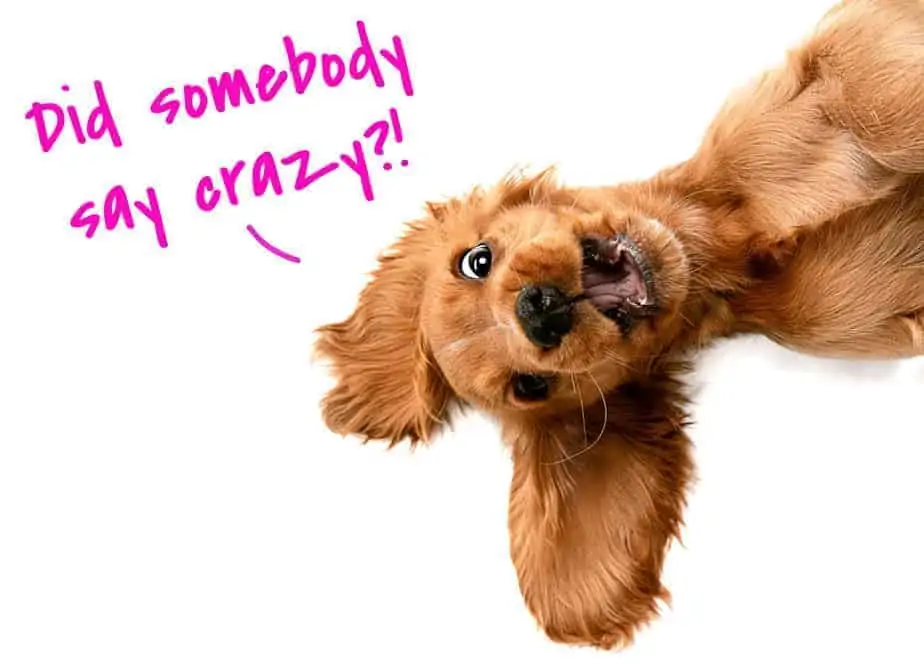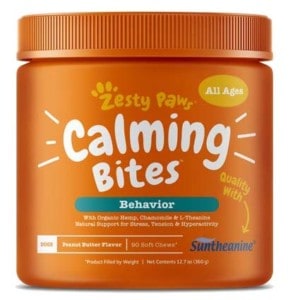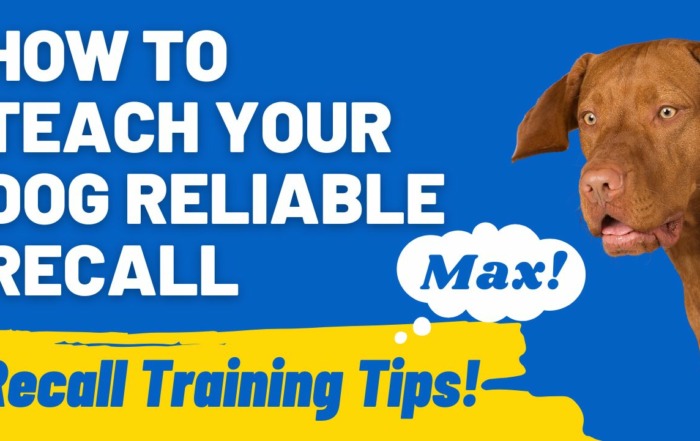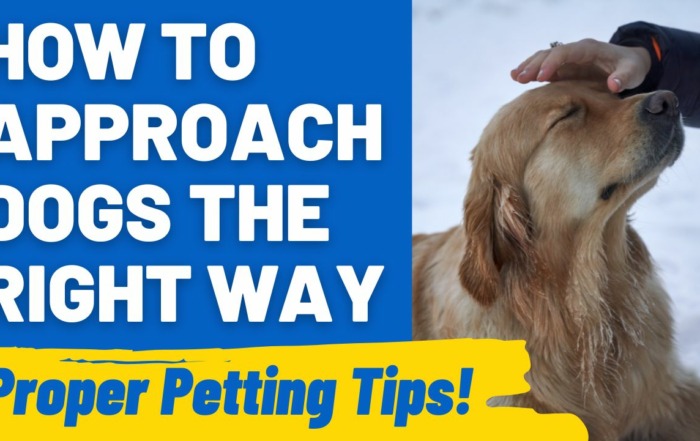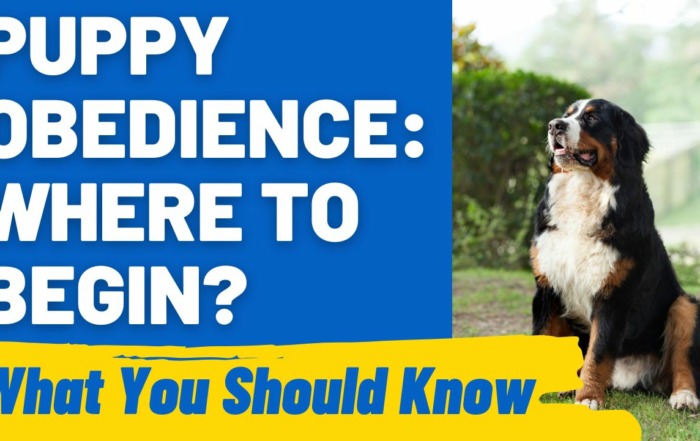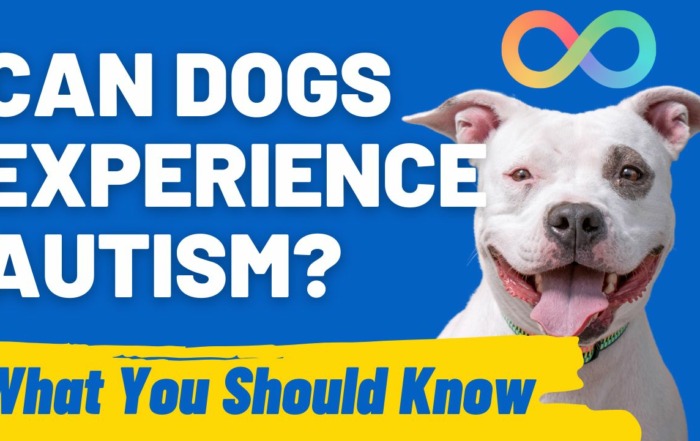A puppy is hard work, especially when they’re difficult to calm down. If you’re wondering when your puppy will calm down, or lose some of that crazy energy, then we’ve got you covered! Check the Table of Contents and skip to what you want to know most.
Though there are breeds that are particularly hyper, all puppies will have high stores of energy, and this energy needs to go somewhere. Usually, it ends up as a destructive tornado!
Because puppies learn and interact through people, you and other family members will often be the brunt of their hyperactivity. A puppy will often have two modes, sleep, and hyper mode.
You can find your fingers and toes chewed, your ears assaulted with barking, your clothes chewed and ripped. And then they’re back asleep looking like a little angel that couldn’t possibly be so crazy.
It can become tiresome trying to gain control over your puppy, but given enough time, patience, and training, you can teach your puppy to calm down.
When Your Puppy Will Calm Down
Puppies calm down between 18 and 24 months. Exactly when they calm down will depend upon their breed and temperament. To help calm down your puppy, be sure to regularly exercise them, have a good supply of toys, and provide positive training methods.
While as a puppy owner it will take patience as they go through this stage, there are some things you should do to help them calm down. Not only the basics mentioned above, but you can also teach them how to settle.
It’s also important to understand their limitations, which is why we wrote a Complete Guide to Puppy Exercise.
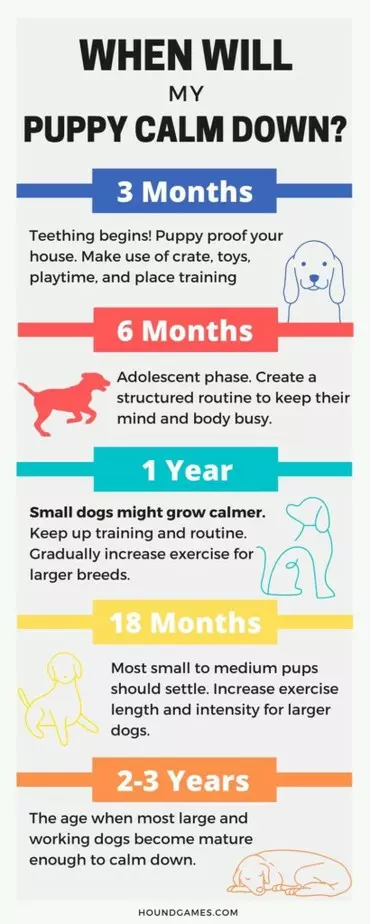
Why Your Puppy is Hyper
Although it’s natural for a puppy to be hyper, sometimes their owner can contribute to this behavior through encouraging excitement. There’s nothing wrong with engaging your puppy through play and enthusiasm, but just be sure to engage them on your terms.
If your puppy gets your attention almost exclusively when they’re jumping all over you, then they will continue this behavior.
They need to know that jumping, barking, biting, or hyperactivity, isn’t the way to getting your attention. Remember to ignore the bad behavior and engage the good with praise and attention.
The Right Way to Correct Bad Behavior
When it comes to training your puppy correct social behavior (such as calm interaction) it’s not all that intuitive.
Whenever your puppy misbehaves or is testing your limits, it can be easy to lash out and tell them off. Anytime you find yourself yelling at your puppy, it’s a time to reassess and take a breath.
The most effective training method for all dogs is to only use positive reinforcement. Using negative training through your anger will only result in a puppy with anxiety and behavioral issues.
If you’re sometimes unsure how to deal with bad behavior or on setting boundaries, be sure to read our post on how to Discipline Your Puppy: Safe and Effective Methods.
If you think your puppy may have a problem with aggression, please read our comprehensive guide to puppy aggression.
What Age Are Puppies Most Hyper and Crazy
Puppies are most hyper during their first year. Their first six months will be their most active as they learn and test their boundaries. After six months they will continue to show bouts of hyperactivity and boundary testing, however, they may also show periods of calmness.
Your puppy will be prone to bouts of hyperactivity all the way through until after their first year of life. Even then, your puppy won’t settle down until they’re approaching their second year.
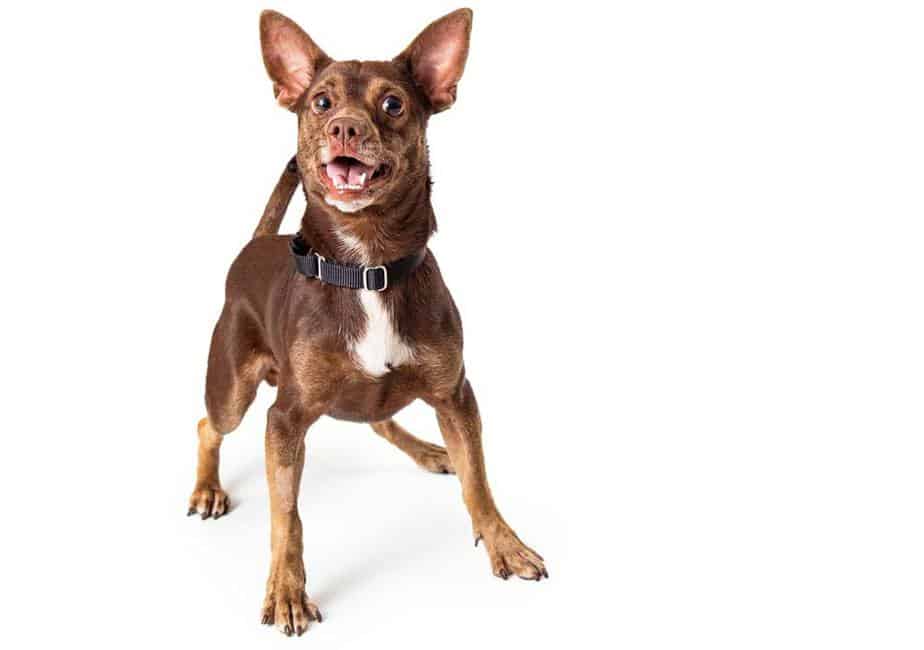
Teenage Puppy
Around the age of 6-months you might find your puppy is going through a “teenager” stage and will rebel against all they’ve learned. It’s important to remain patient through any bouts of rebelliousness and continue positive training reinforcement.
It can be trying when your puppy regresses from training, or they start to exhibit an unwanted behavior, but just remember this time will pass.
All you can do is show them what you like through positive reinforcement. In time they will come around to your way of thinking.
Puppy Stages of Craziness
6 to 12 Weeks
Your puppy will be going through their socialization stage and will need to spend as much time around people and other dogs as possible.
Their interaction with others now will be vital in teaching them some basic manners, especially showing them when they’ve gone too far.
Take your dog to puppy school, but refrain from interacting them with any dogs that may not have had their vaccinations yet. If you have a family with dogs who you know are vaccinated, then these will be good dogs to spend time with.
Other puppies and dogs will do a great job at teaching your puppy where the limit is. And in the absence of dogs, it’s our job as owners to reinforce these boundaries early.
If your puppy bites you, yelp high and loud, just as another pup would.
12 weeks to 6 months
Through this time your puppy will continue to learn their boundaries and be very boisterous as they interact with you and their new world.
Basic training commands should be taught and consistently used throughout this time. This can start giving you the tools to control your puppy.
They will also experience teething now and so may be mouthy.
Your puppy will also likely spend less time interacting with you and more with the world around them. This is likely due to the fact that they have gone through their critical socialization period and now they’re learning their physical boundaries.
This can mean more zoomies and bouts of craziness!
If you feel your puppy has lacked adequate socialization through their earlier weeks, be sure to read our post, Too Late to Socialize Puppy? (Age Expectations).
6 months to 12 months
You may find your dog in the puppy rebellious stage. They will test their boundaries and may not even listen to you when you call them.
When they go through this stage, be sure to never go anywhere without their leash as you’re going to want to keep them under your control as much as possible.
You will require a great deal of patience through this time. But know that it will not last. As stated, the key is to ignore the bad behavior and generously reward the good.
Although your puppy will be much bigger now, they are still a puppy. Which means they’re still learning how to be a good dog.
Your job is to continue training basic commands, positive reinforcement of desired behaviors, social interactions (visiting dog parks once vaccinated), and give them a good daily routine.
A daily routine will help them through this time to understand what is asked of them throughout the day. This can help curb unwanted behaviors.
12 months to 24 months
Your puppy will begin to calm down, though still expect zoomies around the house.
You will start to see the fruits of your labor. The patience you had in their first year will now begin to pay off as they start listening to you more and look to you for direction.
If you continue with a routine of exercise, play time, training, positive reinforcement, ignoring unwanted behaviors, and giving them love and attention, then you’ll be well on your way to an awesome dog!

How to Calm Your Hyper Puppy
There are some techniques you can try to calm an over-stimulated puppy, some more effective than others. Using a holistic approach will be the best method of tackling a puppy who is out of control.
The following tactics can be used to gain control of your crazy pup.
Teach the “Place” Command
The “Place” command is one of the best tools we dog owners have, and is highly underrated.
It can be used when you require your puppy to leave the situation. Whether it’s cooking in the kitchen, when a visitor comes over, or when they need to settle down.
We’ve compiled this guided instruction to teaching your puppy the Place or Mat command.
Training Settle Command
In order to succeed in getting your puppy to stop playing, you need to offer them a reward that is better than what they’re doing. Find treats that your puppy just can’t say no to. These high-value treats will be key in getting your crazy puppy under control.
Over-tiredness
Many times, an overstimulated puppy is just an overtired puppy. Just as a toddler gets overtired and acts out, so can dogs.
You may think they just need more exercise, or playtime, but in reality, what they really need is to settle down and have a sleep.
Puppies should sleep 18 to 20 hours in a day to support their growing bodies and brain. But in a house where there are children, or nowhere for your puppy to calm down, it can be difficult for them to settle.
If you have children, teach them to give your puppy time on their own to settle and sleep. If they’re not already, then it’s a good idea to crate train them.
Supplements
Supplements can definitely have a place in your overall plan of teaching your puppy to calm down. They’re very safe and have good results.
We like PetHonesty Calming Hemp Powder, which can help to alleviate anxiety and stress.
Crate Training
A crate is an excellent tool for your puppy, and we rate it as a must for puppy owners.
They give your puppy a quiet area of their own to calm down and relax. This is a place that can make them feel secure.
It also gives you a tool to instill routine into your puppy’s life.
If your puppy doesn’t like their crate, you may want to read Puppy Doesn’t Like Crate: (Why and What to do)
Exercise
A puppy won’t go for long walks, but they still need to burn off energy. Playtime around a yard can be enough to do this, however, there is still a benefit to walking your puppy, such as teaching them correct leash behavior.
For more about puppy exercise, be sure to read our post Puppy Exercise Guide for 2021: Walking, Running, Outside
You might also like 9 Awesome Indoor Games and Exercises for Your Puppy.
Here is a chart that shows how much walking time your puppy should have at their current age:
| Puppy Age (months) | Exercise Time (minutes) |
|---|---|
| 1 | 5 |
| 2 | 10 |
| 3 | 15 |
| 4 | 20 |
| 5 | 25 |
| 6 | 30 |
| 7 | 30+ |
Toys
Puzzle toys are a must for all dogs. They are a great way to fight boredom, which leads to problem behaviors. We of course recommend our Hide’n’Treat puzzle toys.
One important thing to remember is that you should interact with your puppy and the toys together. Your puppy will find them far more interesting if they think you do too!
And when you’re out, they will associate the toys with playing with you and be more likely to engage with them.
Remember to inspect toys regularly for damage and replace or discard if there’s a problem, as you don’t want them to become a choking hazard, especially when you’re not watching.
You might also like to try our snuffle and lick mat combo for your pup too, which you can see here:
Does your puppy hump their favorite stuffed toy? Then you should probably read our post, Puppy Humping: Is it normal and what to do?
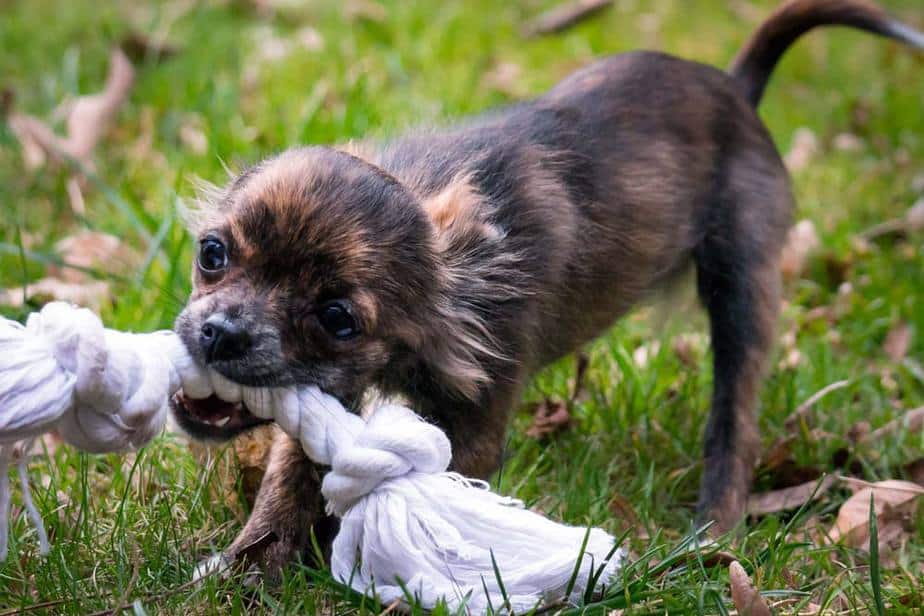
Daytime Routine
A solid and consistent routine will teach your puppy when it’s time to be calm and when it’s time to play.
The below daily puppy routine is ideal, however, it won’t suit everyone, as work can affect your ability to follow it.
You can utilize this routine in your puppy’s life or vary it to suit your lifestyle:
- Set a daily alarm for when you get up. Keep this alarm going on weekends – not forever, but at least for your puppy’s first year. You want your puppy to know that the world doesn’t start until the alarm goes off.
- Take your puppy outside for wees and poos.
- Feed your puppy their first meal of the day.
- Within 5-30 minutes, take your puppy back outside for toileting.
- Now is a good time to play with them outside. Play fetch, tug-of-war, and other running games.
- After outside play, get some high-value treats and go through their basic training commands.
- Your puppy will now be ready for another sleep. Remember your puppy will sleep for 18 to 20 hours a day. You can put your puppy back in their crate for a sleep, or if you haven’t crate trained them, then use the first video under Teach Them How to get them to go to their bed.
- Give them a gentle pet along the length of their body to settle them. If they are hyper and won’t settle, then walk away. Removing your attention from them can be enough to show them that now is not playtime.
- After a nap, it’s always good to go outside for toileting.
- Now will be a good time for a short walk. Puppies can’t walk for extended periods of time, but it’s still important that they get exercise. Even a leash walk around your yard for 5 to 10 minutes will be enough, and you can start teaching them correct leash behavior.
- Invite a friend over or go to a friend’s house for a puppy visit. Early socialization is critical.
- Feed your puppy their second meal of the day.
- Whenever your puppy eats or plays, within 30-minutes they will need to go potty.
- Throughout the day your puppy will take naps. Be sure children in the house leave them in peace during these times.
Nighttime Routine
Having a good night routine is crucial to teaching your puppy how to sleep through the night.
- 30-minutes before a designated bedtime (eg. 9pm), feed your puppy their third meal of the day.
- Play with them for 10 minutes
- Go outside for toileting
- Take them to their crate or bed, and give them a cuddle goodnight
The American Kennel Club also has a good daily routine for puppies which can read here:
Does your puppy have this problem? Puppy is Crying at Night: Why and what to do
Medication to Calm a Crazy Puppy
If you’ve tried everything and can’t seem to train your puppy to calm down no matter what, then you can consider an anti-anxiety or calming medication.
There are many options available and some are more effective than others.
Here are our recommendations for calming medication for puppies:
Pet Honesty Hemp Calming Anxiety and Hyperactivity Soft Chews Supplement
Zesty Paws Stress and Anxiety Calming Bites
Aromatherapy
A study was done by Queen’s University Belfast, with 32 dogs of a history of being over-excited in the car. When these dogs were subjected to the ambient odor of lavender, they were significantly calmer, resting more and barking less.
If you have an aromatherapy burner, then you can consider using a drop of lavender to help calm your pup.
But beware that dogs can smell 10,000 to 100,000 times better than we humans can. Meaning use the lavender drops very sparingly.
Most Hyper Puppy Breeds
Some breeds of dogs will be more hyper than others, especially when they’re puppies. Here is a list of common energetic dog breeds:
- Welsh Corgi
- Australian Shepherd
- Shetland Sheepdog
- Dalmatian
- Doberman
- Border Collie
- English Springer Spaniel
- Miniature Pinscher
- Poodle
- Beagle
- Irish Setter
- German Shepherd
- Jack Russel Terrier
- Yorkshire Terrier
- Siberian Husky
- German Shorthaired Pointer
- Golden Retriever
- Labrador
- Vizsla
If your dog is older than a puppy, you might like to read our post, How To Calm a Hyper Dog.
How to Calm Down Your Puppy from Biting
You can calm your puppy from biting by pulling away your hand and yelping. Your puppy will naturally mouth your hands, but when they bite with any strength be sure to let them know.
When you’re training them not to mouth at all, you should start by teaching them not to mouth with force beforehand. Once they’ve learned this skill, you can start pulling your hand away for more gentle mouthing and make a noise of alarm. It won’t be too long before your puppy knows that you don’t like them mouthing on your hands.
We have this post for more information on this subject: Puppy Biting: When does it stop?
You may also want to read: Puppy Lunging: At Faces, Other Dogs, People or Is Your Puppy Jumping and Ripping Clothes? Do this…
Final Word
A puppy will always be more energetic than an adult dog, and sometimes it may seem they will never settle down.
If you implement some of the above techniques, it can greatly reduce overstimulated puppies and solve some of their crazy antics.
However, puppies will be puppies and at times will be hard to control. It’s important as dog owners that we have patience when teaching our pup’s good behavior.
As we always say, reward the good behavior and ignore the bad.
Good luck on getting your puppy to calm down and we hope this post has helped you and you puppy.
Recall Training Secrets: How to Teach Your Dog Reliable Recall
Teaching a dog recall is not just a basic obedience skill; it's a vital aspect of ensuring the safety and freedom of your beloved pet. Picture this: your dog is playfully chasing after a squirrel [...]
The Joy of Petting: How to Approach Dogs the Right Way
"Can I pet that dog?" is often the first thought that pops into our minds when we see a furry friend wagging its tail. The joy of petting a dog is unmatched, offering both the [...]
Puppy Obedience: Where to Begin? An Introductory Guide
Puppy obedience is more than just teaching commands. It's about nurturing a relationship based on mutual respect and understanding. It lays the foundation for a well-behaved adult dog and ensures a harmonious life together. In [...]
Understanding Canine Autism: Do Dogs Experience It?
Have you ever wondered, can dogs have autism? Autism, a complex condition often characterized by social and communication difficulties, is widely recognized in humans. But when it comes to our canine companions, the idea of [...]

